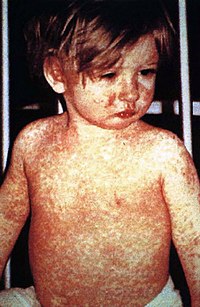
Photo from wikipedia
Introduction Systemic sclerosis (SSc) is thought to be induced by an environmental trigger in genetically predisposed individuals. This study assessed the demographic and clinical characteristics and disease severity of silica… Click to show full abstract
Introduction Systemic sclerosis (SSc) is thought to be induced by an environmental trigger in genetically predisposed individuals. This study assessed the demographic and clinical characteristics and disease severity of silica exposed SSc patients. Methods Data was obtained from the Canadian Scleroderma Research Group (CSRG) cohort, containing 1,439 patients (2004–2019). Univariate and multivariate logistic regression analyses were performed, to determine the phenotype and severity of silica-exposed SSc patients. Mortality was assessed using Cox Survival Regression and Kaplan-Meier analyses. Results Among 1,439 patients (86.7% females), 95 patients reported exposure to silica. Those exposed were younger, of male sex and with more severe disease. Sex differences were observed where male patients exposed to silica were more likely to be Caucasian and smokers whereas female patients were younger at SSc diagnosis compared to unexposed. Multivariate regression, controlled for multiple confounders, showed that silica exposure was associated with a younger age at diagnosis and worse disease severity and mortality. Conclusion Exposure to silica was reported in ∼7% of CSRG cohort and ∼20% of male patients and was associated with a worse prognosis in terms of age of diagnosis, organ involvement and mortality. Hence, screening for silica exposure among higher risk individuals may be beneficial and these patients may require closer monitoring for systemic disease.
Journal Title: Frontiers in Medicine
Year Published: 2022
Link to full text (if available)
Share on Social Media: Sign Up to like & get
recommendations!